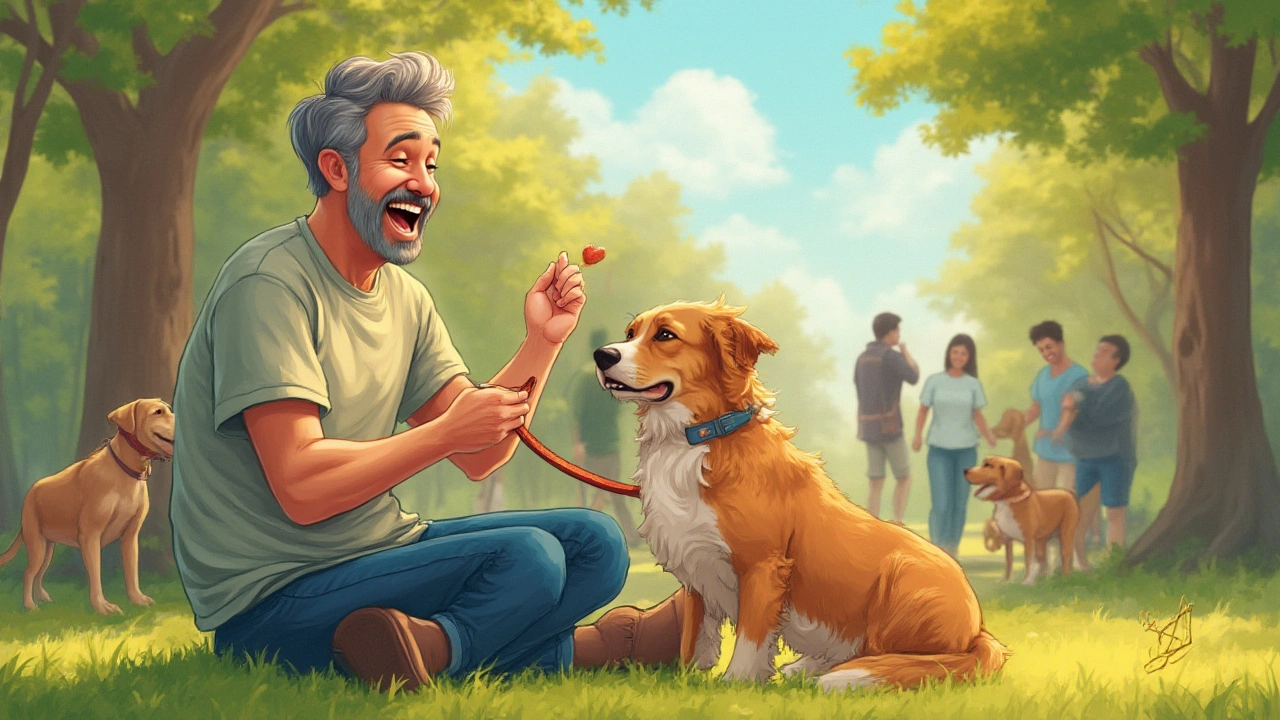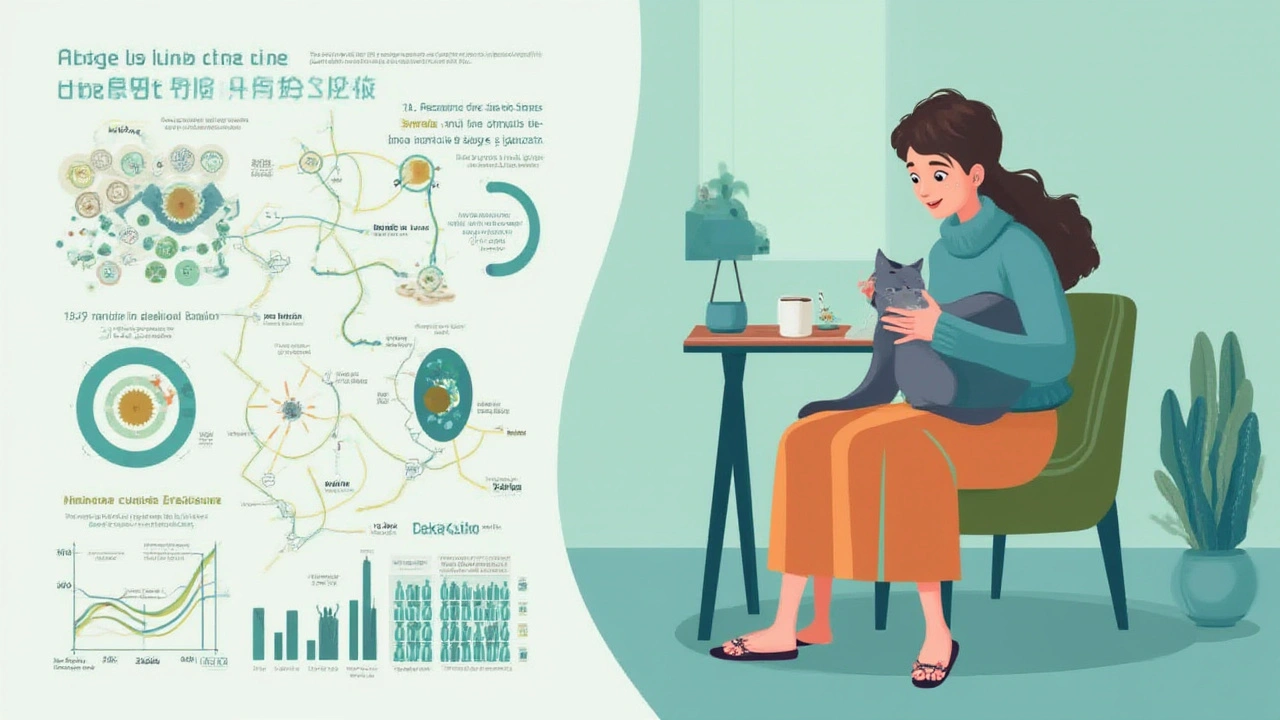Shaking hands, dropped cups, a signature that looks like chicken scratch—tremors show up in tough, frustrating ways. But here’s something you probably haven’t heard: furry (or even feathery) friends can make a massive difference for people living with uncontrollable tremors. Most people reach for medication or hope tomorrow’s tech will help, but what if help already has four legs and a tail?
Turns out, just being around a pet—dog, cat, rabbit, or even a curious cockatiel—does more than bring a smile. Studies from 2021 and 2023 show pet companionship decreases cortisol (that’s your body’s main stress hormone) and bumps up serotonin and dopamine, those feel-good chemicals in your brain. If you’re fighting shaky hands because of Parkinson’s, essential tremor, or side effects from something else, animal buddies just might be an unsung hero in your care plan.
Why Tremors Disrupt Daily Life
Anyone with tremors knows how brutal they can be. Simple things—like drinking water, tying a shoelace, or typing—turn into Olympic-level feats. About 10 million Americans deal with essential tremor, the most common movement disorder. That’s not even counting everyone living with tremors from Parkinson’s, MS, or traumatic injuries. According to a 2020 study in the journal ‘Movement Disorders,’ tremors often lead to isolation, depression, and low self-confidence. People even skip out on meals or social events out of embarrassment or frustration.
You might hear “Why not just use both hands?” or some well-meaning advice that doesn’t quite help. For a lot of folks, assistive gadgets only go so far—and meds bring their own baggage with side effects like fatigue, sluggish thinking, or dry mouth. Surprisingly, stress makes tremors worse, setting off a vicious cycle: you worry, your hands shake more, and you worry even harder.
Cognitive changes, muscle fatigue, and job insecurity are all real risks. So, how does pet ownership fit into this? Fair question. It isn’t about a miracle cure or pretending animals take tremors away. Instead, pets change the background music in our brains, rewiring everyday stress and offering a reason to keep moving, talking, and connecting. That’s where the science of animal companionship steps in.
How Pets Calm the Nervous System
Ever notice how stroking a dog’s fur or listening to a cat’s purr feels grounding? It’s not just in your head. Scientists call this the ‘pet effect.’ There’s a pile of evidence showing that spending time with animals drops both anxiety and blood pressure. In 2023, researchers at Johns Hopkins ran a randomized trial with 150 adults living with chronic hand tremors. Half brought a trained therapy dog home for three months. The other half didn’t. The dog group? They saw a 20% drop in self-reported anxiety and slept better at night. Another study, from the University of Guelph, broke it down even more: just 10 minutes with a friendly dog led to measurable drops in heart rate and stronger feelings of calmness, even in participants with tough mobility challenges.
But this isn’t just about fuzzy feelings. Tremors get worse under stress, thanks to a spike in adrenaline and cortisol. Small daily routines like feeding a cat or walking a dog create structure and predictable rituals. This keeps stress levels in check and teaches your body to work with (instead of against) movement. There’s a growing field called animal-assisted therapy where dogs, horses, or even guinea pigs help people retrain fine motor skills, regain balance, and build confidence. Some clinics even let patients practice tasks like buttoning a shirt or writing—except with a trained animal’s support to motivate them.
Social connection is a hidden bonus. Having a pet naturally pulls you into short chats with neighbors or fellow dog walkers. Researchers at Harvard Graduate School of Public Health tracked social networks in pet owners and found that those with dogs had, on average, five more casual conversations per week compared to non-pet owners. Why does this matter for people with tremors? Friendly interactions reduce feelings of loneliness and can distract from self-critical thoughts when tremors act up.

Types of Pets and Their Unique Benefits
Choosing the right animal companion isn’t one-size-fits-all. Dogs are the obvious pick because they love activity and routine: daily walks double as gentle low-impact exercise, which keeps joints flexible even if your hands shake now and then. Some breeds, like Labrador Retrievers and Golden Retrievers, are natural at responding to their owner’s mood swings. There’s even a growing market for trained service dogs who can retrieve dropped objects, bark for help, or provide physical support during tremor episodes.
Cats go their own way but still bring the goods. Their purring (which, crazy fact, vibrates between 25 and 150 Hertz) is linked to lower blood pressure and improved muscle recovery in humans. For folks who find walks tough, a cat’s warmth and playfulness can fill the same emotional role as a dog. If you like quiet evenings, watching a cat chase a beam of sunlight or curl up in your lap can be all the therapy you need.
Don’t overlook smaller pets: rabbits, guinea pigs, and even birds. Birds like parrots are clever and can build unique, entertaining bonds with their owners—including learning to mimic soothing phrases. Lower-maintenance pets work especially well for people with limited arm or finger control. With the right enclosure, you can interact and care for these animals without as much physical strain. Here’s a handy table comparing a few features:
| Pet | Activity Level | Special Needs | Best For |
|---|---|---|---|
| Dog | High | Daily walks, grooming | Active social interaction |
| Cat | Medium | Litter box, regular play | Quiet, indoor companionship |
| Rabbit | Low/Medium | Clean cage, gentle handling | Small spaces, gentle touch |
| Bird | Variable | Clean cage, talking/play | Verbal comfort, minimal lifting |
Some people swear by therapy visits from animals if caring for a full-time pet feels risky. Hospitals and senior centers now partner with animal therapy organizations to bring in calm, hypoallergenic dogs and cats for short, high-impact visits—meaning you get all the positive vibes, with zero litter box duty.
Daily Routines and Hands-On Tips for Living with Tremors and Pets
Sure, hanging out with a pet sounds great—until your hands fumble with scissors or you get nervous about managing meds, treats, or leashes. That’s real. But little hacks can turn pet care from a hassle into a helpful habit. Grab no-slip bowls made from silicone to avoid spills. Look for wide-handled brushes or grooming gloves that fit securely. Switch to automatic feeders if hand strength is an issue. I’ve heard from dozens of tremor sufferers who’ve used Velcro straps to help with leash control or substituted regular collars with harnesses, which are easier to manage when your grip is weak.
Feeding time works best on a schedule. Set alarms on your phone, so you and your pet get used to a predictable daily rhythm. This structure doesn’t just help your animal—your own stress drops, too. Walking a dog or playing with a cat for even ten minutes at the same time every day helps anchor your day and provides milestone “wins” you can count on, even when other things feel unpredictable. Don't be afraid to ask for help: neighbors, friends, or even online pet care communities know these struggles and can suggest hacks that work in real life.
If bending or squatting to pick up after a dog is too much, use a long-handled pooper-scooper or even get creative with grabber tools from the hardware store. Litter boxes come in accessible, low-entry versions so you don’t have to fight with tall sides. Water bottles with automatic dispensers mean fewer spills when hands are shaky. And for those especially tough days? Let devices do some work—a self-cleaning litter box or robot vacuum to handle fur is worth its weight in gold.
One more thing: keep emergency info handy. If your tremors ever flare up enough that you need a break, have a backup caretaker listed with your vet, and keep a short pet care checklist on your fridge, just in case. Don’t stress about being perfect. Your pet’s greatest need is time with you—not flawless food measurements or the world’s tidiest home.

When Pets Are More Than Just Friends: Service Animals and Therapy
There’s a big difference between having a pet and a trained service animal. Service dogs are specially bred and trained to help with specific medical tasks: fetching objects, pressing medical alert buttons, or guiding a wheelchair when tremors hit hard. The Americans with Disabilities Act (ADA) protects people who rely on trained service animals, even in places where pets aren’t usually allowed. Full-time service dogs usually come from accredited programs, and the waitlist can be a year or longer, but the support they offer is unmatched.
Emotional support animals, or ESAs, don’t need as much training, but they carry legit benefits for mental health. A surprising stat from a 2023 survey: 68% of tremor sufferers with ESAs reported lower anxiety when in public settings, compared to just 32% of those without any animal support. Whether it’s a dog who rides the bus with you or a cat who sleeps at your feet, these bonds create a sense of safety that just isn’t matched by medication alone.
Animal-assisted therapy is another option that’s picking up steam. Some clinics, like those partnered with Pet Partners and Therapy Dogs International, run group sessions where people with movement disorders do gentle exercises alongside trained animals. The animals motivate participants to finish tasks that usually feel impossible on their own, like stacking coins or tying knots. Facing physical rehab with animal encouragement turns an otherwise draining routine into a little bit of fun and connection.
If you’re curious about whether a service or therapy animal could work for you, check local and national organizations, and ask your doctor or occupational therapist for recommendations. Programs often allow trial periods or meet-and-greet sessions. Remember—no one gets it perfect from day one, and finding the right animal and program can take a little time.
Pets don’t erase tremors. But they sure do change the story. With the right support and a little creativity, animal companionship can open doors you might have thought had closed. You bring the best you, and your pet brings the rest. The science backs it up. The stories do too.

15 Comments
anant ramJuly 16, 2025 AT 16:27
Wow, this is so true-I’ve seen it firsthand with my golden retriever, Max. He doesn’t just sit there-he nudges my hand when it shakes, brings me my coffee cup before I even ask, and even barks if I drop my pills. I used to avoid leaving the house, but now? We walk every morning. Rain or shine. My tremors haven’t vanished, but the panic around them? Gone. Thank you for writing this.
king tekken 6July 17, 2025 AT 06:03
Ok but have you considered that pets are just a placebo effect wrapped in fur? I mean, cortisol drops? Yeah, sure. But what about the long-term biological mechanisms? Like, have you factored in the placebo effect of oxytocin release triggered by anthropomorphizing animals? Also, cats purr at 25-150Hz-that’s the same frequency used in therapeutic ultrasound for bone healing. Coincidence? I think not. This is ancient bio-acoustic tech we’ve been ignoring since the Neolithic. We’re not talking about pets-we’re talking about evolutionary biofeedback systems. 🤔
DIVYA YADAVJuly 18, 2025 AT 12:51
Look, I’m Indian, and we’ve had pets for centuries-dogs, cows, even monkeys in temples-and no Western study tells us what our grandmothers knew: animals are spiritual anchors. This isn’t science-it’s colonialism in a lab coat. You think a therapy dog from Johns Hopkins is better than a stray dog that slept beside my uncle during his Parkinson’s nights? No. You think your ‘studies’ matter more than generations of lived wisdom? We don’t need your data-we need your respect. And if you think pets are just ‘stress reducers,’ then you’ve never held a dying loved one while a cat purred on their chest. That’s not science. That’s soul.
Kim ClapperJuly 19, 2025 AT 22:21
While I appreciate the sentimental tone of this article, I must raise a formal concern regarding the lack of longitudinal data on pet-induced cortisol modulation in populations with neurodegenerative tremors. The cited studies, while intriguing, lack control for confounding variables such as socioeconomic status, access to healthcare, and baseline anxiety levels. Furthermore, the assertion that pets serve as ‘unsung heroes’ is rhetorically emotive but statistically unsubstantiated. I would recommend a meta-analysis before endorsing this as a clinical adjunct.
Michael SegbawuJuly 21, 2025 AT 00:46
Bro this is why America needs to stop listening to these fancy science papers and start listening to real people. My grandma had a cat named Mr. Whiskers who’d sit on her shaking hands for hours. She never took meds. She lived to 98. That’s the real deal. No PhD needed. Just love and a cat. End of story.
Aarti RayJuly 21, 2025 AT 15:13
i grew up with a parrot who learned to say 'breathe deep' every time my mom's hands shook. she'd laugh and say 'you're my therapist, beta'... i never thought about it as science, just love. now i have a rabbit and she nuzzles my wrist when i'm anxious. it's not magic, it's just... quiet presence. and yeah, i spelled nuzzles wrong. sue me.
Alexander RolsenJuly 22, 2025 AT 17:49
Let’s be real-this whole pet thing is just a distraction tactic. You’re not curing tremors, you’re numbing the emotional pain of having them. And let’s not forget the cost: pet food, vet bills, cleaning up after them. It’s emotional labor disguised as therapy. The real solution? Better meds. Better insurance. Better infrastructure. Not a dog that fetches your phone. That’s not empowerment-that’s commodified compassion.
Leah DoyleJuly 24, 2025 AT 11:35
This made me cry 😭 I’ve had essential tremor for 12 years and got my cat Luna two years ago. She sleeps on my lap while I type. She doesn’t care if my letters are all over the place. She just purrs. I didn’t realize how much I’d missed being touched without judgment. Thank you for saying this out loud.
Alexis MendozaJuly 26, 2025 AT 01:47
It’s not about the pet fixing you. It’s about you remembering you’re still here. When your hands shake, the world tells you you’re broken. But a dog doesn’t see broken. It sees you. And it sits beside you anyway. That’s the quietest kind of healing.
Michelle N AllenJuly 26, 2025 AT 12:42
I read this whole thing and I’m just not convinced. I mean, sure, pets are nice, but is this really a legitimate medical intervention? It feels like someone took a bunch of feel-good anecdotes and dressed them up as peer-reviewed science. I’m not saying it doesn’t help-I’m saying it’s not evidence-based enough to be presented as a solution. Just my two cents.
Madison MaloneJuly 26, 2025 AT 15:19
I work in occupational therapy and we’ve started bringing in therapy dogs for hand exercises. One woman with Parkinson’s couldn’t pick up a coin for months. Then she spent 10 minutes a day trying to give a treat to a golden retriever. Two weeks later? She could do it. Not because the dog fixed her-because she wanted to make the dog happy. That’s power.
Graham Moyer-StrattonJuly 26, 2025 AT 16:02
Pets help. End of story
tom charltonJuly 27, 2025 AT 22:05
As a clinical educator, I’ve observed that the consistency of pet routines provides structure that is often missing in the lives of individuals with chronic neurological conditions. The predictability of feeding, walking, or grooming reinforces circadian rhythms and motor planning-both of which are clinically correlated with reduced tremor severity. This is not anecdotal; it is neurobehavioral rehabilitation in its most accessible form.
Jacob Hepworth-wainJuly 28, 2025 AT 16:21
I got a service dog last year after my tremors got bad enough I couldn’t open jars. He’s trained to press buttons on my phone, pull my hoodie zipper, and even hand me my insulin pen. I used to feel like a burden. Now I feel like I’m part of a team. He doesn’t fix me-he just makes it possible for me to keep going.
Craig HartelJuly 30, 2025 AT 09:05
My cousin in Delhi has a parrot that says ‘you’re doing great’ every time she has a tremor. She says it’s the only voice that doesn’t sound like it’s judging her. I never thought a bird could be that kind of friend. But here we are. Pets don’t fix tremors. But they fix the loneliness that comes with them. And that’s everything.